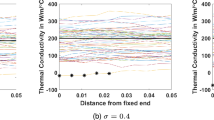Abstract
This work aims to improve heat flux distribution models to predict the temperature during drilling. The workpiece temperature is simulated by applying heat flux load only on the hole wall surface. Finite element method is used to simulate the temperature over process time. An iterative identification algorithm using particle swarm optimization (PSO) enables to identify the heat flux distribution parameters through the best fit of the experimental and calculated temperatures. Two heat flux density distributions presented in the literature, namely linear and polynomial, are investigated. A concentrated heat flux distribution is calculated based on measured torque and serves for a comparison purpose. Additionally, the polynomial approach is expanded by adding a concentrated heat flux in order to compensate the lack of hole bottom surface. The best results in terms of residual temperature are obtained for the hybrid heat flow distribution.













Similar content being viewed by others
References
Aurich JC, Zimmermann M, Schindler S, Steinmann P (2014) Analysis of the machining accuracy when dry turning via experiments and finite element simulations. Prod Eng 8(1-2):41–50
Battaglia J, Puigsegur L, Cahuc O (2005) Estimated temperature on a machined surface using an inverse approach. Exp Heat Transfer 18(1):13–32
Biermann D, Iovkov I (2013) Modeling and simulation of heat input in deep-hole drilling with twist drills and MQL. Procedia CIRP 8:88–93
Biermann D, Iovkov I, Blum H, Rademacher A, Taebi K, Suttmeier F, Klein N (2012) Thermal aspects in deep hole drilling of aluminium cast alloy using twist drills and MQL. Procedia CIRP 3:245–250
Blanc G, Raynaud M, Chau TH (1998) A guide for the use of the function specification method for 2D inverse heat conduction problems. Revue gé,nérale de thermique 37(1):17–30
Bono M, Ni J (2002) A model for predicting the heat flow into the workpiece in dry drilling. J Manuf Sci Eng 124(4):773–777
Bono M, Ni J (2006) The location of the maximum temperature on the cutting edges of a drill. Int J Mach Tools Manuf 46(7):901–907
Chen L, Tai BL, Yang JA, Shih AJ (2017) Experimental study and finite element modeling of workpiece temperature in finish cylinder boring. J Manuf Sci Eng 111(11):003
Cui M, Gao X, Zhang J (2012) A new approach for the estimation of temperature-dependent thermal properties by solving transient inverse heat conduction problems. Int J Therm Sci 58:113–119
Deng S, Hwang Y (2006) Applying neural networks to the solution of forward and inverse heat conduction problems. Int J Heat Mass Transfer 49(25):4732–4750
Denkena B, Schmidt C, Krüger M (2010) Experimental investigation and modeling of thermal and mechanical influences on shape deviations in machining structural parts. Int J Mach Tools Manuf 50 (11):1015–1021
Faverjon P, Rech J, Valiorgue F, Orsetti M (2015) Optimization of a multi-drilling sequence with MQL supply to minimize thermal distortion of aluminum parts. J Mach Eng 15
Fleischer J, Pabst R, Kelemen S (2007) Heat flow simulation for dry machining of power train castings. CIRP Ann-Manuf Technol 56(1):117–122
Gosselin L, Tye-Gingras M, Mathieu-Potvin F (2009) Review of utilization of genetic algorithms in heat transfer problems. Int J Heat Mass Transfer 52(9):2169–2188
Han S, Faverjon P, Valiorgue F, Rech J (2018) Prediction and modeling of thermal distortion in sequential MQL drilling of AlSi7 cylindrical parts. Procedia CIRP 77:336–339
Kakade N, Chow J (1993) Finite element analysis of engine bore distortions during boring operation. Trans-Am Soc Mech Eng J Eng Ind 115:379–379
Kennedy J, Eberhart R (1995) Particle swarm optimization. In: Proceedings of 1995 IEEE International Conference on Neural Networks, pp 1942–1948
Klocke F (2018) Fertigungsverfahren 1 – Zerspanung mit geometrisch bestimmter Schneide. Berlin, Springer Vieweg
Kuzu A, Berenji KR, Ekim B, Bakkal M (2017) The thermal modeling of deep-hole drilling process under MQL condition. J Manuf Process 29:194–203
Lauro CH, Brandão L C, Vale TJS, Luis Christóforo A (2013) An approach to define the heat flow in drilling with different cooling systems using finite element analysis. Adv Mech Eng 5:612, 747
Lu S, Heng Y, Mhamdi A (2012) A robust and fast algorithm for three-dimensional transient inverse heat conduction problems. Int J Heat Mass Transfer 55(25):7865–7872
Macedo SEM (2015) Thermoelastische verformungen von werkstücken aus leichtmetall bei der trockenbearbeitung. Rheinisch-Westfälischen Technischen Hochschule Aachen. Dr.-Ing. Dissertation., Aachen
Ozisik MN (2000) Inverse heat transfer: fundamentals and applications. CRC Press, Cleveland
Pontes DW (2017) Experimental and numerical determination of the forced convection coefficient of the cutting fluid in drilling machining (in Portuguese). Master’s thesis, Universidade do Estado de Santa Catarina
Sato M, Aoki T, Tanaka H, Takeda S (2013) Variation of temperature at the bottom surface of a hole during drilling and its effect on tool wear. Int J Mach Tools Manuf 68:40–47
Segurajauregui U, Arrazola PJ (2015) Heat-flow determination through inverse identification in drilling of aluminium workpieces with MQL. Prod Eng 9(4):517–526
Soković M, Mijanović K (2001) Ecological aspects of the cutting fluids and its influence on quantifiable parameters of the cutting processes. J Mater Process Technol 109(1):181–189
Tai BL, Stephenson DA, Shih AJ (2012) An inverse heat transfer method for determining workpiece temperature in minimum quantity lubrication deep hole drilling. J Manuf Sci Eng 134(2):021,006
Tai BL, Stephenson DA, Shih AJ (2013) Workpiece temperature during deep-hole drilling of cast iron using high air pressure minimum quantity lubrication. J Manuf Sci Eng 135(3):031,019
Yusup N, Zain AM, Hashim SZM (2012) Overview of pso for optimizing process parameters of machining. Procedia Eng 29:914–923
Acknowledgments
The authors would like to thank the research funding agencies CAPES for the scholarships granted to the post-graduate student participating in the study.
Author information
Authors and Affiliations
Corresponding author
Ethics declarations
Conflict of interest
The authors declare that they have no conflict of interest.
Additional information
Publisher’s note
Springer Nature remains neutral with regard to jurisdictional claims in published maps and institutional affiliations.
Rights and permissions
About this article
Cite this article
Medeiros, J.C., Filho, J.M.C. A comparison of different heat flux density distribution models to predict the temperature in the drilling process. Int J Adv Manuf Technol 109, 1997–2008 (2020). https://doi.org/10.1007/s00170-020-05720-0
Received:
Accepted:
Published:
Issue Date:
DOI: https://doi.org/10.1007/s00170-020-05720-0




